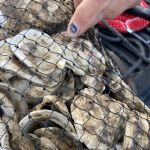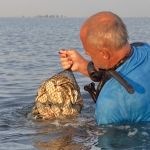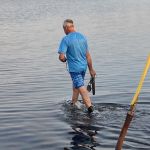Great South Bay Oyster Project
Photo Gallery
Recent Progress
Volunteer
Habitat Restoration

Habitat Restoration
We advocate for healing the creeks that feed our bay, for bay-friendly yards, for helping to return a shellfishing industry to the Great South Bay, and for the deployment of modern wastewater treatment technologies to address the problems caused by 500,000 cesspools and septic tanks, as well as the 197 large scale septic systems in malls, apartment complexes and locally.
Volunteer
Lend a hand! Join our Oyster Project Team and help revive The Great South Bay.
Partnering With Oyster Growers
Of course, nothing happens without cleaner water. That is why getting rid of our cesspools and septic tanks, healing our creeks, tackling runoff, and practicing natural lawn care is so important.
Please contact us with any suggestions you may have. You can also donate our efforts. We want to apply the latest techniques in aquaculture to revitalize our bay, our economy and our local culture.
We advocate for healing the creeks that feed our bay, for bay-friendly yards, for helping to return a shell fishing industry to the Great South Bay, and for the deployment of modern wastewater treatment technologies to address the problems caused by 500,000 cesspools and septic tanks, as well as the 197 large scale septic systems in malls, apartment complexes and locally.
Where You Can Get Fresh, Long Island Blue Point Oysters
- Neguntatogue Oysters (Lindenhurst) – call or text Keith & Nicole at 631-275-8046
- Blue Island Oysters (Sayville)- Call Chris at (631) 563-1330 for availability
- Maris Stella Oysters (Captree) – call or text Sixto at 516-939-5545
- Little A’s (Bay Shore) – call or text Michael at 917-526-1900
- Red Tiger (West Islip) – call or text Lou at 646-228-6273
The Making Of An Oyster Sanctuary
Site Evaluation
Establishing the Sanctuary
Enhancing and Measuring for Success
Recent Progress On Habitat Restoration
Can Long Island Be Saved, Part V: Cuomo’s Initiative to Improve Water Quality and Coastal Resilience
he die offs of vegetation (marshes, eel grass, sea grass) and wildlife (fish, shellfish, birds, insects, amphibians and reptiles) have been stunning. Whole habitats are vanishing before our eyes. At the same time, that nitrogen is seeping ever more deeply into our drinking water into the aquifer that sits below us, with water deposited there by glacier melt eons ago.
Not only are nitrogen rates rising, but the rate of the rise is too, as the plume of nitrogen created by the explosive population growth on Post War Long Island, much unsewered, has generated a plume of nitrogen that is now making its way downward into our drinking water.
Can Long Island Be Saved? Part IV — Crescent Beach, Beach Closures and Cesspools
Crescent Beach is a microcosm, an all too familiar story. There are 500,000 septic systems and cesspools in Nassau (140K) and Suffolk (360K). Along the North Shore of Nassau County, in places like Manhasset, Bayville, Glen Cove, and Oyster Bay, in Kings Point, in thirty communities total, marshland has all but vanished and the waters become unswimmable because of the nitrogen and bacteria leeching from these low lying tanks and cesspools.
Can Long Island Be Saved? Part II — Public Forum on Water Quality and Resiliency May 12th, Theodore Roosevelt Executive Offices
The first of four public meetings scheduled this month on Long Island’s water quality crisis was held Monday, May 12, 12-4 p.m. in the Nassau County Legislative Chambers which are appropriately enough in the Theodore Roosevelt Executive Office Building at 1550 Franklin Avenue, Mineola. The next meeting will be at Stony Brook University May 19, time and place TBD.
A Late Earth Day Present From Governor Cuomo — An Initiative to Improve Water Quality and Resiliency on Long Island
Governor Andrew M. Cuomo today announced that New York will undertake an intensive and collaborative review of clean water needs in Nassau and Suffolk counties to increase resiliency against future storms, improve water quality and provide additional protections for Long Island’s groundwater resources. This review will be undertaken in a series of meetings in conjunction with Nassau County Executive Ed Mangano and Suffolk County Executive Steve Bellone and with additional participation from federal officials and key community, business and environmental stakeholders. Following the review, recommendations will be provided to the Governor for immediate action.
The Long Island Clean Water Partnership – A Roster
The mission of the partnership is to build awareness among Long Islanders as to the threats to our drinking water, our bays, rivers and ponds so that we can address these threats. The largest threat our water faces on Long Island is the nitrogen pollution in our groundwater from 500,000 septic tanks. It sparks the algal blooms that are killing off all our waters. Then there are also high nitrogen fertilizers, polluted storm runoff, pesticides. Each of these 100+ organizations, and the individuals here listed are dedicated to addressing our groundwater pollution problems before it is too late, and our lakes rivers, ponds and bays are lifeless and our drinking water compromised.
The Suffolk County Comprehensive Water Resources Management Plan — The Anatomy of a Crisis For Long Island
So what will the county do? What will Long Island do? Clearly, it will take billions to address the septic tank issue. That’s where the IBM Smarter Cities award will come in handy. Suffolk County won $500,000 worth of consulting from IBM to study the issue of sewer and waste water treatment planning. Rest assured, when it comes time to remove and replace the 100,000 septic tanks with something green, they will have a full, complete and accurate inventory, and a process. Beyond that, everyone — the governor, our senators — agree that we need sewer systems and modern waste water treatment technology and the funding to make that possible.




















